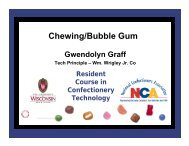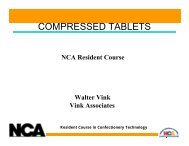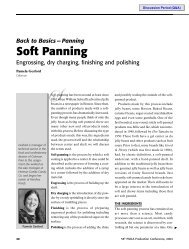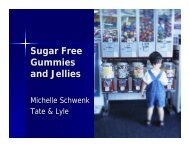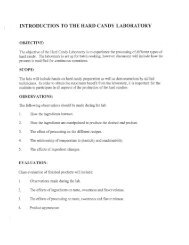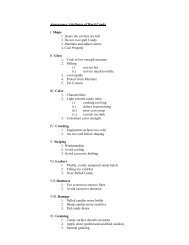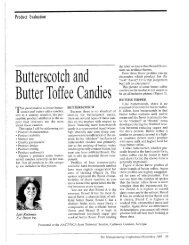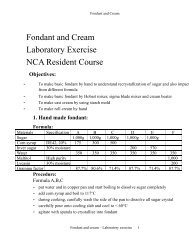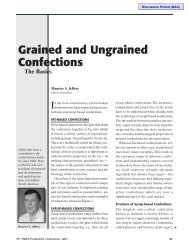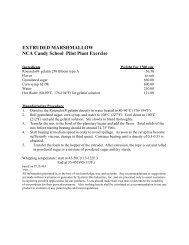2003 Caramel--Raw Materials and Formulations - staging.files.cms ...
2003 Caramel--Raw Materials and Formulations - staging.files.cms ...
2003 Caramel--Raw Materials and Formulations - staging.files.cms ...
Create successful ePaper yourself
Turn your PDF publications into a flip-book with our unique Google optimized e-Paper software.
Back To Basics – <strong>Caramel</strong><br />
<strong>Caramel</strong> — <strong>Raw</strong> <strong>Materials</strong><br />
<strong>and</strong> <strong>Formulations</strong><br />
Mark Heim<br />
Hershey Foods Corporation<br />
Over the last couple of years, the Back<br />
to Basics sessions have covered high<br />
boils, fondants <strong>and</strong> cremes. Those sessions<br />
showed you how to make both grained <strong>and</strong><br />
ungrained confections <strong>and</strong> how their ingredients<br />
<strong>and</strong> processes would control the finished<br />
product form. The basics given then<br />
for mixing carbohydrates, usually sucrose<br />
<strong>and</strong> a corn syrup, <strong>and</strong> the effects of their<br />
ratio <strong>and</strong> final moisture on the syrup phase<br />
for texture, water activity <strong>and</strong> graining still<br />
apply in making a caramel, as well as any<br />
sugar confection.<br />
A caramel uses your knowledge of carbohydrates<br />
<strong>and</strong> then adds milk to develop<br />
a confection with its own unique properties<br />
in flavor, color <strong>and</strong> texture, so we need to<br />
similarly underst<strong>and</strong> the effects of adding<br />
milk. When adding milk, you are actually<br />
introducing three new components to your<br />
recipe: the milk proteins, the milk fat <strong>and</strong><br />
the milk sugar.<br />
The milk proteins can be broken down<br />
to casein <strong>and</strong> whey proteins, roughly at a<br />
ratio of 80 to 20. The casein will have most<br />
of its effect on texture, making the confection<br />
chewier, adding more body <strong>and</strong> giving<br />
it some elasticity. The whey proteins most<br />
affect the color <strong>and</strong> flavor that we are so<br />
familiar with.<br />
The milk fat helps in flavor <strong>and</strong> also in<br />
texture by reducing stickiness <strong>and</strong> softening<br />
the bite. The fat in the amount of milk<br />
we add is not enough to do a good job, so<br />
additional fat is added, either as more milk<br />
fat or more commonly as hydrogenated vegetable<br />
fats.The melting curve of the fat used<br />
will have a significant effect on the finished<br />
caramel texture, flavor <strong>and</strong> product st<strong>and</strong>up.<br />
Milk fat provides the rich, flavorful profile<br />
but will result in a soft piece due to its<br />
low melt point <strong>and</strong> a shorter shelf life due<br />
to its unstable fatty acids. The higher-melt<br />
hydrogenated fats will help firm up the<br />
caramel without making it much chewier<br />
or tougher <strong>and</strong> help it have a longer shelf<br />
life as they are more stable, but will not contribute<br />
as much to the rich flavor.<br />
The milk sugar is lactose. It provides a<br />
low intensity sweetness, but keep in mind<br />
that it is not very soluble <strong>and</strong> its low solubility<br />
can be a concern in how it processes<br />
<strong>and</strong> its effect on the finished piece.<br />
Heim currently leads<br />
the product development<br />
innovations<br />
team for Hershey<br />
Foods Corp. where he<br />
has been a confectioner<br />
for 27 years. His<br />
work has been in both<br />
chocolate <strong>and</strong> nonchocolate<br />
product<br />
development.<br />
Mark Heim<br />
22 57 th PMCA Production Conference, <strong>2003</strong><br />
➤
MAILLARD REACTION<br />
As just mentioned, the uniqueness of<br />
caramel is due in part to the milk proteins.<br />
The reaction of these proteins with<br />
the reducing sugars in a recipe is called a<br />
Maillard reaction. This reaction produces<br />
brown nitrogenous polymers or<br />
melanoidins, which contribute to the flavor,<br />
color <strong>and</strong> texture. The reaction itself<br />
goes through too many steps to cover here<br />
so just remember the basics:<br />
• It is a reaction between amino acids <strong>and</strong><br />
reducing sugars.<br />
• It is affected by the type <strong>and</strong> levels of<br />
amino acids <strong>and</strong> reducing sugars.<br />
• It is affected by temperature (slow below<br />
100°F, fast above 200°F).<br />
• It is affected by time, the thermal profile<br />
at each stage of the process.<br />
• It is affected by pH, faster at higher pH.<br />
• It is affected by moisture level throughout<br />
the process.<br />
A TWO-PHASE CONFECTION<br />
<strong>Caramel</strong> is often a two-phase confection,<br />
continuous <strong>and</strong> dispersed.To visualize this,<br />
imagine wet s<strong>and</strong>.The s<strong>and</strong> is the dispersed<br />
phase, the water the continuous phase.<br />
With the s<strong>and</strong>, using water gives you a texture<br />
for forming your desired shapes. In<br />
our caramel, the s<strong>and</strong> is the crystallized<br />
sugars <strong>and</strong> the water is the syrup.As in the<br />
wet s<strong>and</strong>, the ratio of dispersed <strong>and</strong> continuous<br />
phase will affect the texture, from<br />
something you can pour, to something you<br />
can shape, to something that is dry <strong>and</strong><br />
crumbly.<br />
The syrup or continuous phase is made<br />
up of the water <strong>and</strong> all ingredients that can<br />
remain dissolved in the water.What cannot<br />
stay in solution will crystallize or precipitate<br />
out to form the dispersed phase. This<br />
syrup affects texture <strong>and</strong> controls shelf life.<br />
The water level has the greatest influence<br />
in controlling texture, primarily hardness.<br />
<strong>Caramel</strong> — <strong>Raw</strong> <strong>Materials</strong> <strong>and</strong> <strong>Formulations</strong><br />
The dissolved-sugars ratio controls sticki- The level of water<br />
ness, chewiness <strong>and</strong> toughness. The level <strong>and</strong> types of sugars<br />
of water <strong>and</strong> types of sugars together will together will<br />
control water activity, determining shelf control water<br />
life <strong>and</strong> what kind of protection the prod- activity,<br />
uct will need, from moisture pick-up or determining shelf<br />
loss, to cold flow. The proteins affect the life <strong>and</strong> what kind<br />
body or elasticity. This continuous phase of protection the<br />
can be like a lubricant that allows the dis- product will need.<br />
persed particles to flow or even pour as in<br />
a syrup, or it can be like a binder or glue to<br />
hold them in a given shape to the extent of<br />
a hard c<strong>and</strong>y.The key is knowing what you<br />
want that continuous phase to do for your<br />
particular product, how you want it to<br />
behave <strong>and</strong> its effect on texture, flavor <strong>and</strong><br />
shelf life.<br />
The dispersed phase is not only made<br />
up of the sugars that crystallize out, but<br />
also oil, fat, precipitates <strong>and</strong> any inclusions<br />
such as nutmeats. What makes up the dispersed<br />
particles will affect texture differently.Their<br />
overall quantity or ratio of dispersed<br />
to continuous will affect how long<br />
or short the texture will be (go back to the<br />
wet s<strong>and</strong> <strong>and</strong> compare the pourable to the<br />
crumbly). The particle size affects surface<br />
area, affecting the amount of syrup that is<br />
needed just to coat the particles, like comparing<br />
wet s<strong>and</strong> to wet clay <strong>and</strong> similarly<br />
the possible range of textures of your confection.Their<br />
hardness also has an effect on<br />
texture. Is it a hard sugar crystal or a<br />
deformable oil globule? Even particulate<br />
shape has its effect.<br />
The characteristics of your finished product<br />
will then be the result of the properties<br />
of each phase <strong>and</strong> how both phases<br />
complement each other.<br />
Once you figure all this out, you then<br />
have to know what characteristics you<br />
need at each phase of your process. Is it a<br />
small kettle batch cook of a few pounds or<br />
a large-scale continuous process of more ➤<br />
57 th PMCA Production Conference, <strong>2003</strong> 23
<strong>Caramel</strong> — <strong>Raw</strong> <strong>Materials</strong> <strong>and</strong> <strong>Formulations</strong><br />
The characteristics<br />
of your finished<br />
product will then be<br />
the result of the<br />
properties of each<br />
phase <strong>and</strong> how both<br />
phases complement<br />
each other.<br />
than 1,000 lbs an hour? How long will it<br />
take to cook or cool to temperature? How<br />
much shear is involved? Are you depositing<br />
or extruding? How much graining, if<br />
any, do you need when forming? Is it to be<br />
held <strong>and</strong> used later as a component to a<br />
more elaborate confection? Then, what<br />
do you want to happen after packaging<br />
so it’s perfect when the consumer eats it?<br />
These are some of the questions you have<br />
to not only ask, but also to underst<strong>and</strong><br />
the answers.<br />
A CARAMEL RECIPE<br />
First, let’s describe caramel. Depending on<br />
who you ask, you can get a variety of<br />
answers.You’ll even get different pronunciations.<br />
Answers will range from a flowable<br />
ice cream topping to a glassy hard<br />
c<strong>and</strong>y. It can be part of a c<strong>and</strong>y bar as a<br />
layer to add texture <strong>and</strong> flavor, something<br />
that is sticky to hold peanuts or other inclusions<br />
in place, or one of the favorite fillings<br />
in a box chocolate, where it can be<br />
shaped with good st<strong>and</strong>-up for enrobing<br />
or flowable enough at cooler temperatures<br />
for shell-moulded c<strong>and</strong>y. The most recognizable<br />
form may be the brown cubeshaped,<br />
soft <strong>and</strong> creamy confection. But<br />
even this last description can vary; is it a<br />
chewy, long-textured, ungrained piece or<br />
is it a tender, short, grained one? Is it<br />
fudge? Once you’ve decided exactly what<br />
it is that you want to make <strong>and</strong> how it is to<br />
function, you can then begin to determine<br />
what your recipe will be <strong>and</strong> which raw<br />
materials to use.<br />
There are hundreds of recipes <strong>and</strong> such<br />
a wide range of raw materials available<br />
that it can become very confusing as to<br />
where to begin, let alone how to modify<br />
your recipe to get the exact product you<br />
want. There are some basic parameters<br />
often given, such as ratio of sucrose to corn<br />
syrup, level of milk proteins <strong>and</strong> so on, but<br />
to me that just limits your possibilities <strong>and</strong><br />
creativity. After all, if you want to make<br />
something different, you have to do it differently.<br />
It first comes down to knowing<br />
exactly what you want to make. You can<br />
start by looking at the variety of books <strong>and</strong><br />
articles (e.g., as in the Manufacturing Confectioner)<br />
that are available <strong>and</strong> start with<br />
one that comes closest to what you want in<br />
a caramel.You can even start with the label<br />
of an existing product.<br />
Underst<strong>and</strong>ing the Recipe<br />
Following the old adage that it is better to<br />
teach a person how to fish than to give him<br />
a fish, we will show you how to get a better<br />
underst<strong>and</strong>ing of your recipe <strong>and</strong> the raw<br />
materials <strong>and</strong> how to use that underst<strong>and</strong>ing<br />
to modify your recipe to best fit your<br />
process <strong>and</strong> give you that perfect caramel<br />
you want to make. So, rather than give<br />
parameters that may limit you, we’ll just<br />
start with a recipe we’ve found <strong>and</strong> learn<br />
what to do to underst<strong>and</strong> it so you can<br />
meaningfully change it as necessary.<br />
<strong>Caramel</strong> Recipe<br />
Water . . . . . . . . . . . . . . . . . . . . . . . . . . . 170.0 g<br />
Sugar, granulated . . . . . . . . . . . . . . . . . . 454.0 g<br />
Corn Syrup, 42de/a . . . . . . . . . . . . . . . . 369.0 g<br />
Sweetened condensed whole milk . . . . 312.0 g<br />
Partially hydrogenated vegetable fat . . . . 184.0 g<br />
Salt . . . . . . . . . . . . . . . . . . . . . . . . . . . . . . 14.0 g<br />
Soy lecithin . . . . . . . . . . . . . . . . . . . . . . . . . 2.5 g<br />
Figure 1<br />
This recipe (Figure 1) looks fine <strong>and</strong> is<br />
written just as you need it for batching in<br />
production. But it really doesn’t tell us<br />
what is in there. So to better underst<strong>and</strong> a<br />
recipe, change it into a formula. In other<br />
words, break it down so you know exactly<br />
what it is you’re working with.<br />
Let’s start going through the recipe<br />
ingredients <strong>and</strong> break them down where<br />
we can.Then we can discuss their purpose<br />
<strong>and</strong> see how together they make that particular<br />
caramel. For this paper, the num-<br />
24 57 th PMCA Production Conference, <strong>2003</strong><br />
➤
ers used are simplified to help you underst<strong>and</strong><br />
things easier. For your use, talk to<br />
your supplier <strong>and</strong> find out exactly what is<br />
in the raw material you are using.<br />
Ingredients<br />
Water — 170.0 g No, we’re not going to<br />
break down the water but just make a few<br />
comments. Its level before, after <strong>and</strong> at<br />
each stage of the process can have a lot of<br />
influence.With other ingredients, you may<br />
be off a percent or two <strong>and</strong> it will modify<br />
the product some if it does anything at all.<br />
If you are off a percent or two on water, the<br />
following could happen:<br />
• The caramel could grain when you don’t<br />
want it to or not grain when you do.<br />
• It could be too hard or too soft.<br />
• It could be less stable due to the water<br />
activity being too high, where you have<br />
problems with micro if sealed or its tendency<br />
to dry out if not; or too low, with<br />
problems of it picking up moisture <strong>and</strong><br />
requiring more expensive packaging.<br />
As an ingredient before cook, a starting<br />
point for how much water to add is about<br />
one-third the level of sugar, to help make<br />
sure all the sugar is dissolved. This of<br />
course will change due to the process you<br />
use. For after cook, it’s the final texture<br />
you want that determines how much water<br />
is left. For each of the processing stages,<br />
it’s how fast or slow you want to develop<br />
the color <strong>and</strong> flavor or the when <strong>and</strong> how<br />
it will or will not grain.<br />
Don’t forget about the water quality.<br />
You write specifications <strong>and</strong> have quality<br />
control checks for all of your ingredients,<br />
yet even with the importance of the water<br />
in your recipe, how many of you know<br />
what is in your water? The best example is<br />
if it’s too acidic you may need to use a<br />
buffer salt to prevent the milk proteins<br />
from denaturing or precipitating out,<br />
Sugar, granulated — 454.0 g Sugar we can<br />
break down.Although for this exercise you<br />
<strong>Caramel</strong> — <strong>Raw</strong> <strong>Materials</strong> <strong>and</strong> <strong>Formulations</strong><br />
Breakdown of Sugar, Granulated<br />
Sugar . . . . . . . . . . . . . . . . . . . . . . . . . . . . 454.0 g<br />
Sucrose (99%) . . . . . . . . . . . . . . . . . . 449.5 g<br />
Invert (1%) . . . . . . . . . . . . . . . . . . . . . . . . 4.5 g<br />
Dextrose (50%) . . . . . . . . . . . . . . . . . . . . 2.25 g<br />
Fructose (50%) . . . . . . . . . . . . . . . . . . . . 2.25 g<br />
Figure 2<br />
Breakdown of Corn Syrup 42 DE/A<br />
Corn syrup . . . . . . . . . . . . . . . . . . . . . . . . . . . 369.0 g<br />
Dextrose (18% dry, 14.5% wet) . . . . . . . 53.5 g<br />
Maltose (14% dry, 11.0% wet) . . . . . . . . 40.6 g<br />
Polysaccharides (68% dry, 54.5% wet) 201.1 g<br />
Water (20% wet) . . . . . . . . . . . . . . . . . . . . . .73.8 g<br />
Figure 3<br />
can assume no moisture, you can also<br />
assume there will be some inversion. For<br />
this paper, we’ll keep the numbers simple<br />
<strong>and</strong> assume 1 percent inversion. So now<br />
our recipe looks like Figure 2.<br />
Some confectioners prefer using brown<br />
sugar to partially replace the sucrose,<br />
developing a very nice change to the overall<br />
flavor. When you do, be sure to get its<br />
breakdown. It will contain some invert<br />
sugar <strong>and</strong> ash, with the invert sugar affecting<br />
texture, solids of the syrup phase <strong>and</strong><br />
water activity, while the ash affects processing<br />
(foaming) <strong>and</strong> both affect the Maillard<br />
reaction.<br />
Corn syrup, 42 DE/A— 369.0 g Corn syrup<br />
can also be broken down more. For the<br />
sake of simplicity, we’ll break it down only<br />
to DP1, 2, 3+ (DP1–dextrose, DP2–maltose,<br />
DP3+–higher saccharides) <strong>and</strong> its<br />
water level. The breakdown percentages<br />
are simplified to demonstrate the idea<br />
(Figure 3).<br />
Again, check with your supplier for exact<br />
numbers.There are many corn syrups available,<br />
with different ranges of the components<br />
<strong>and</strong> even with different components.<br />
Sweetened condensed whole milk—<br />
312.0 g Now to break down the scwm.To<br />
keep this part simple we’ll break it down to<br />
➤<br />
You write<br />
specifications <strong>and</strong><br />
have quality control<br />
checks for all of<br />
your ingredients,<br />
yet even with the<br />
importance of the<br />
water in your<br />
recipe, how many<br />
of you know what<br />
is in your water?<br />
57 th PMCA Production Conference, <strong>2003</strong> 25
<strong>Caramel</strong> — <strong>Raw</strong> <strong>Materials</strong> <strong>and</strong> <strong>Formulations</strong><br />
So many things<br />
about the milk can<br />
have an effect. The<br />
differences in the<br />
raw milk itself, how<br />
it was processed,<br />
stored <strong>and</strong><br />
reconstituted, all<br />
have their effect,<br />
mostly due to<br />
protein quality.<br />
Breakdown of Sweetened Condensed<br />
Whole Milk<br />
Scwm . . . . . . . . . . . . . . . . . . . . . . . . . . . . . . . 312.0 g<br />
Sucrose (61.1% dry, 44.0% wet) . . . . . 137.3 g<br />
Butterfat (11.8% dry, 8.5% wet) . . . . . . . 26.5 g<br />
Lactose (14.6% dry, 10.5% wet) . . . . . . . 32.8 g<br />
Protein (12.5% dry, 9.0% wet) . . . . . . . . 28.1 g<br />
Water (28% wet) . . . . . . . . . . . . . . . . . . . . . 87.3 g<br />
Figure 4<br />
the sugar, fat, lactose, total protein <strong>and</strong><br />
water levels.The numbers again are examples<br />
(Figure 4).<br />
Look at the sugar in the scwm, it’s<br />
almost a quarter of all the sucrose in the<br />
caramel recipe <strong>and</strong> most of the solids of the<br />
ingredient. Remember to check with your<br />
supplier for exact numbers.<br />
There are many other forms of milk that<br />
can be used or even different components<br />
from milk such as just adding casein or<br />
whey.The casein mostly affects texture by<br />
adding body <strong>and</strong> the whey proteins add<br />
color <strong>and</strong> flavor.They could be used to cut<br />
costs or modify your texture or flavor.<br />
Again, break them down, for example, for<br />
the lactose usually found in the whey. If<br />
adding more casein or whey, break down<br />
the protein above so you know how much<br />
you’re starting with.<br />
So many things about the milk can<br />
have an effect. The differences in the raw<br />
milk itself, how it was processed, stored<br />
<strong>and</strong> reconstituted, all have their effect,<br />
mostly due to protein quality. You need to<br />
find which of the differences will affect<br />
your caramel <strong>and</strong> then you need to control<br />
them.<br />
Partially hydrogenated vegetable fat —<br />
184.0 g We won’t break the fat down, but<br />
here are the critical numbers of the fat:<br />
• The melt point — the higher the melt<br />
point, the better the st<strong>and</strong>-up, but be<br />
careful going above 92°–95°F as it can<br />
start to give it a waxy texture <strong>and</strong> flavor.<br />
• The solid fat index (sfi)—this will let<br />
you know how sharp a melt curve you<br />
will have. This can influence the flavor<br />
release.<br />
Other factors in deciding are resistance to<br />
oxidation <strong>and</strong> even how the fats are added.<br />
Blending several fats before emulsification<br />
can yield overall softer fats due to<br />
eutectic effect.<br />
Salt — 14.0 g The salt is used primarily to<br />
enhance flavor.<br />
Soy lecithin — 2.5 g The soy lecithin is an<br />
emulsifier, ensuring a good dispersion<br />
<strong>and</strong> homogenization of the fat. Other<br />
emulsifiers can be used to help with specific<br />
needs of your caramel. For example,<br />
gms can be used to help with st<strong>and</strong>-up<br />
or to help with cutting a caramel that is<br />
sticky. Talk to your suppliers to determine<br />
which are best for your needs. Don’t<br />
forget that the milk proteins also help in<br />
emulsification <strong>and</strong> in some cases may be<br />
all you need. Just make sure you have the<br />
level <strong>and</strong> type of emulsifier correct. If too<br />
much, you’re wasting money <strong>and</strong> it could<br />
even contribute to off flavor or texture<br />
<strong>and</strong> if too little, it could oil out.<br />
Other ingredients It is common to use carbonates,<br />
phosphates or other buffers to<br />
adjust the pH of your caramel. If the pH is<br />
too low, below the isoelectric point of the<br />
milk proteins (~4.6), the proteins will precipitate.As<br />
the pH rises, you affect the rate<br />
of the Maillard reaction, but if it is too high<br />
your flavor quality decreases.A good starting<br />
point is a pH between 6 <strong>and</strong> 6.5.<br />
You can use other ingredients to modify<br />
texture <strong>and</strong> flavor, such as various nutmeats<br />
<strong>and</strong> vanilla or vanillin. Starches or<br />
other thickeners can be used to modify<br />
product texture <strong>and</strong> your process.<br />
Putting it all Together<br />
Now rewrite your recipe <strong>and</strong> turn it into<br />
a formula. Our recipe turns into Figure 5. ➤<br />
26 57 th PMCA Production Conference, <strong>2003</strong>
Simplify It<br />
Combine similar ingredients. Now you<br />
have your formula (Figure 6).<br />
A next step would be to add another column<br />
with water at your finished moisture<br />
level <strong>and</strong> recalculate the percentage of your<br />
dries accordingly. If you go to available data<br />
on how much sugar your final corn syrup<br />
<strong>and</strong> moisture levels will hold, you can tell<br />
how much sucrose, if any, will potentially<br />
grain, but remember that viscosity also<br />
affects graining. You can set this process<br />
up in a spreadsheet program, tie it all<br />
together <strong>and</strong> then with just a few keystrokes<br />
know exactly how your recipe<br />
changes will affect your formulation. You<br />
can combine the components into their<br />
type (sugars, fats) or functions (texture/flavor),<br />
etc., for whatever works for the purpose<br />
of your doing this. How far you pull<br />
apart <strong>and</strong> rearrange is up to you <strong>and</strong> what<br />
you want to get out of it.<br />
If you want to change your recipe, look<br />
at its formula, look at which components<br />
will make the changes you’re looking for<br />
<strong>and</strong> look at which raw materials provide<br />
those components.<br />
Now you can make better-informed<br />
decisions. You know exactly what has<br />
changed in your formula <strong>and</strong> then can look<br />
at the product made before <strong>and</strong> after the<br />
changes to see their effects in your process.<br />
UNDERSTAND YOUR COMPONENTS<br />
Take the time to learn more about what<br />
your components will <strong>and</strong> will not do.<br />
See how their combinations affect texture,<br />
flavor, color, shelf life <strong>and</strong> behavior<br />
in processing.<br />
General affects you should know are<br />
shown in Figure 7.<br />
You can find further effects of your raw<br />
materials in literature or from your supplier;<br />
this is only to get you started.<br />
<strong>Caramel</strong> — <strong>Raw</strong> <strong>Materials</strong> <strong>and</strong> <strong>Formulations</strong><br />
REVIEW OF STAGES<br />
• Get your starting recipe from books,<br />
articles, wrappers, etc., or one you currently<br />
use.<br />
• Break it down, change it to a formula.<br />
• Try it, evaluate it <strong>and</strong> decide where to<br />
take it.<br />
• Decide what to change, components or<br />
process.<br />
Revised <strong>Caramel</strong> Recipe<br />
Water . . . . . . . . . . . . . . . . . . . . . . . . . . 170.0 g<br />
Sugar<br />
Sucrose . . . . . . . . . . . . . . . . . . . . . . 449.5 g<br />
Dextrose . . . . . . . . . . . . . . . . . . . . . . . . 2.25 g<br />
Fructose . . . . . . . . . . . . . . . . . . . . . . . . 2.25 g<br />
Corn Syrup<br />
Dextrose . . . . . . . . . . . . . . . . . . . . . . . 53.5 g<br />
Maltose . . . . . . . . . . . . . . . . . . . . . . . 40.6 g<br />
Polysaccharides . . . . . . . . . . . . . . . . 201.1 g<br />
Water . . . . . . . . . . . . . . . . . . . . . . . . . 73.8 g<br />
Sweetened Condensed Whole Milk<br />
Sucrose . . . . . . . . . . . . . . . . . . . . . . 137.3 g<br />
Butterfat . . . . . . . . . . . . . . . . . . . . . . . 26.5 g<br />
Lactose . . . . . . . . . . . . . . . . . . . . . . . . 32.8 g<br />
Protein . . . . . . . . . . . . . . . . . . . . . . . . 28.1 g<br />
Water . . . . . . . . . . . . . . . . . . . . . . . . . 87.3 g<br />
Partially hydrogenated vegetable fat . . 184.0 g<br />
Salt . . . . . . . . . . . . . . . . . . . . . . . . . . . . . 14.0 g<br />
Soy lecithin . . . . . . . . . . . . . . . . . . . . . . . . 2.5 g<br />
Figure 5<br />
Simplified <strong>Caramel</strong> Recipe<br />
Ingredient Weight % Wet % Dry<br />
Dextrose 55.75g 3.72% 4.77%<br />
Fructose 2.25g 0.17% 0.21%<br />
Sucrose 586.80g 38.98% 49.97%<br />
Maltose 40.60g 2.7% 3.46%<br />
Lactose 32.80g 2.18% 2.79%<br />
Polysaccharides 201.10g 13.36% 17.12%<br />
Protein 28.10g 1.87% 2.39%<br />
Fats 210.50g 13.98% 17.92%<br />
Soy lecithin 2.50g 0.17% 0.21%<br />
Salt 14.00g 0.93% 1.19%<br />
Water 331.20g 22.00% —<br />
Total<br />
Figure 6<br />
1,505.50g 100.06% 100.04%<br />
➤<br />
If you go to<br />
available data on<br />
how much sugar<br />
your final corn<br />
syrup <strong>and</strong> moisture<br />
levels will hold, you<br />
can tell how much<br />
sucrose, if any, will<br />
potentially grain,<br />
but remember that<br />
viscosity also<br />
affects graining.<br />
57 th PMCA Production Conference, <strong>2003</strong> 27
<strong>Caramel</strong> — <strong>Raw</strong> <strong>Materials</strong> <strong>and</strong> <strong>Formulations</strong><br />
If you reformulate the recipe, do the following:<br />
• Decide which components will affect<br />
your change <strong>and</strong> how much more or less<br />
you need.<br />
• Look at the source of those components.<br />
• Make the appropriate recipe changes.<br />
• Confirm all the changes made by ingredients<br />
on your formula.<br />
• Test the changes.<br />
• Compare formula changes to finishedproduct<br />
changes.<br />
Once you have this set up on your spreadsheet<br />
to give you the information you’re<br />
most comfortable using, you can make<br />
changes quickly <strong>and</strong> easily. Even doing it<br />
longh<strong>and</strong> can save you time over guessing.<br />
The more you underst<strong>and</strong>, the more<br />
you can figure it out <strong>and</strong> the more effective<br />
your work will be, in formulating or troubleshooting.<br />
When comparing samples, don’t just<br />
look at the ingredients <strong>and</strong> finished product.<br />
Follow your changes through your<br />
process so you know where they start to<br />
affect the caramel <strong>and</strong> how much.<br />
As confectioners you are artists, combining<br />
selected materials into a form with<br />
an appearance, aroma, flavor, texture <strong>and</strong><br />
even sound that delivers an experience to<br />
your customer. How many art forms affect<br />
all five senses? And any true artist underst<strong>and</strong>s<br />
their materials <strong>and</strong> tools, what they<br />
will <strong>and</strong> will not do <strong>and</strong> how they can be<br />
altered <strong>and</strong> formed to deliver that experience<br />
to your customer.<br />
So don’t just know, underst<strong>and</strong>. Knowing<br />
gives you specifics <strong>and</strong> can only take<br />
you so far; underst<strong>and</strong>ing gives you possibilities<br />
<strong>and</strong> will take you anywhere. ■<br />
REFERENCES<br />
Lees, <strong>and</strong> Jackson. Sugar Confectionery &<br />
Chocolate Manufacture.<br />
Minifie, Bernard. Chocolate, Cocoa <strong>and</strong> Confectionery.<br />
General Effects of Ingredients<br />
Dextrose <strong>and</strong> Fructose<br />
Monosaccharides.<br />
Reduce water activity.<br />
React strongly with the milk proteins in<br />
Maillard reaction (fructose > dextrose).<br />
Higher levels soften the product <strong>and</strong> increase<br />
stickiness.<br />
Help more sucrose stay in solution, increasing<br />
finished solids of the syrup phase.<br />
Sucrose<br />
Disaccharide.<br />
Bulk filler.<br />
Provides most of the sweetness.<br />
Does not react with milk proteins in the Maillard<br />
reaction; it is not a reducing sugar.<br />
Higher levels make harder or can grain.<br />
How much stays in solution depends on level of<br />
moisture <strong>and</strong> the ratio with other sugars present.<br />
Also rework, shear <strong>and</strong> its thermal history<br />
after cook.<br />
Maltose<br />
Disaccharide.<br />
Texturally similar to sucrose in syrup phase.<br />
Reacts with the milk proteins in the Maillard reaction,<br />
but much less than the monosaccharides.<br />
Lactose<br />
Disaccharide.<br />
Very low solubility, tendency to grain.<br />
Reacts with the milk proteins in Maillard reaction, but<br />
much less than the monosaccharides.<br />
Polysaccharides<br />
Provide texture, chewier, firmer, tougher, less cold<br />
flow.<br />
Help control graining by increasing viscosity.<br />
No significant reaction with the milk proteins in the<br />
Maillard reaction.<br />
Protein<br />
Know how much casein versus whey proteins.<br />
Casein gives it texture, body.<br />
Whey gives it color, flavor.<br />
Know quality of proteins, how effective.<br />
Fats/Emulsifiers<br />
Rreduce stickiness.<br />
Give st<strong>and</strong>-up (differs by melt point).<br />
Modify bite.<br />
Control processing.<br />
Flavor — quality, release, rancidity (add antioxidant).<br />
If blending fats, emulsify before (firmer) or after<br />
blending (softer).<br />
How well emulsified<br />
–Color<br />
–Surface oiling<br />
Emulsifier type<br />
–e.g., gms, use less, more st<strong>and</strong>-up.<br />
Figure 7<br />
28 57 th PMCA Production Conference, <strong>2003</strong>



